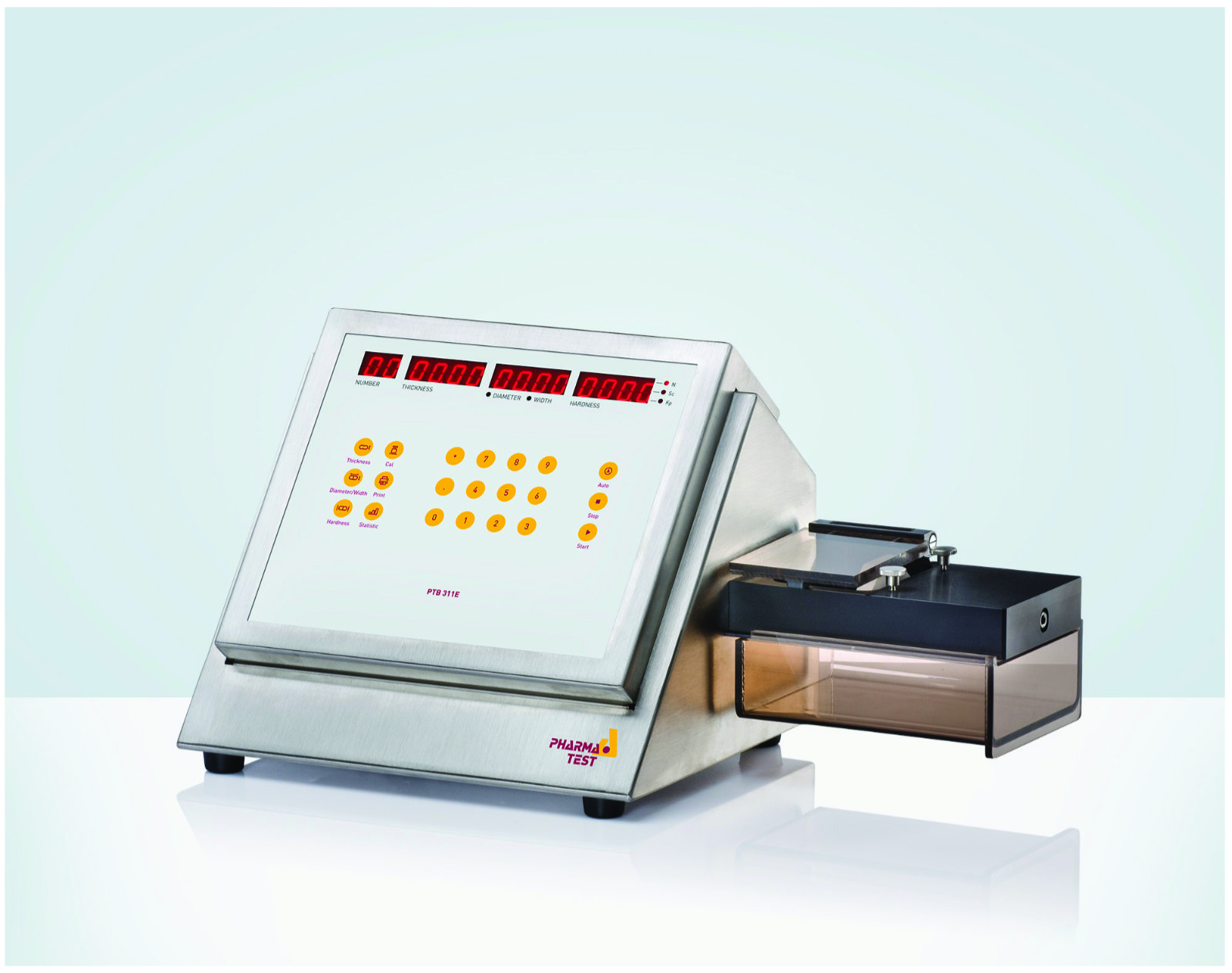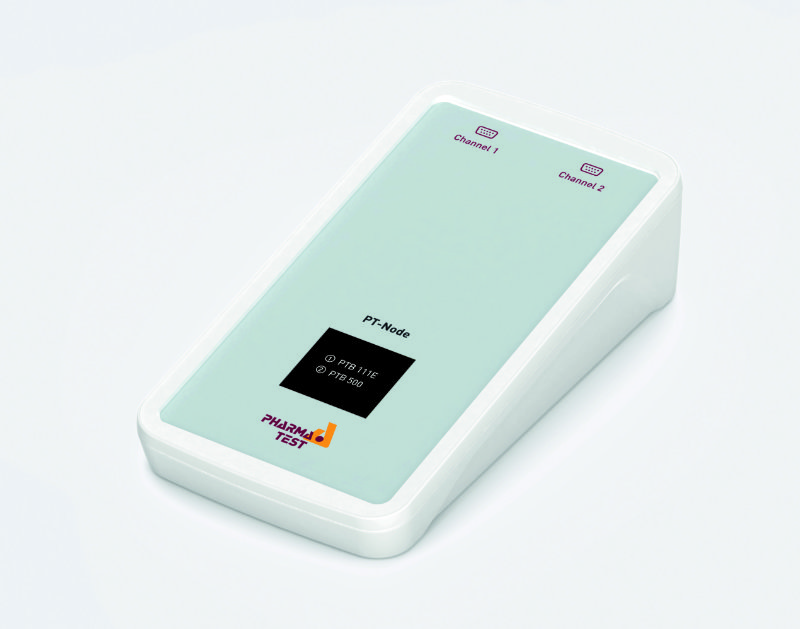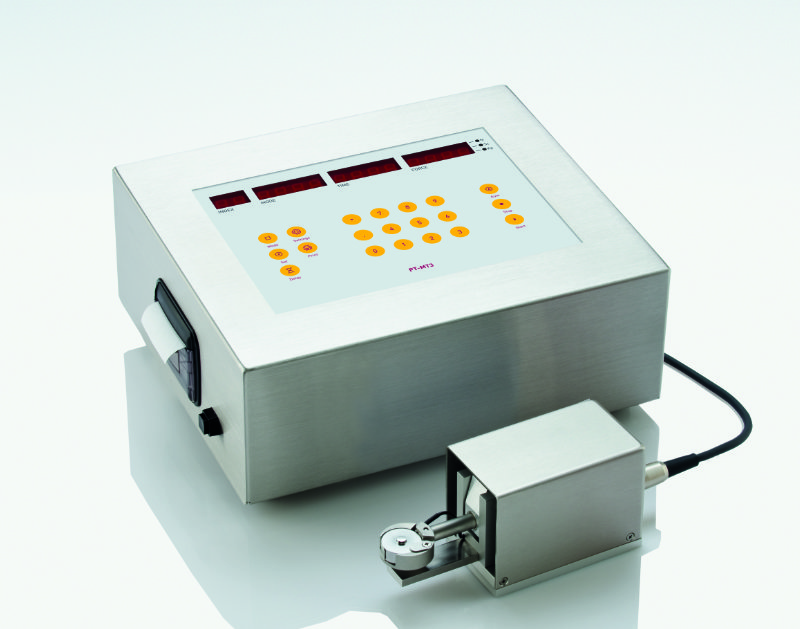Test Procedure
Enter the nominal test information for thickness, width, diameter (length) and hardness as well as a batch number via the PTB 311E keyboard. Now place the sample upright into the testing station and start the test. The jaw will move forward, touch and force the tablet at its highest point to measure the thickness, then reverse back so that the sample falls into a horizontal position. To measure the width of an oblong just rotate the tablet by hand so that the long side aligns with the force sensor. The jaw will move forwards against the force sensor and thereby detect the width of the sample in between. The jaw then returns to its home position. Now the tablet is positioned orthogonally to the force sensor to test its diameter (or length), immediately followed by its hardness (or tablet breaking force). The units to measure can be selected between mm or Inch, KP (Kilopond), N (Newton) or Sc (Strong Cobb).
The four results are immediately displayed. Diameter and width share a button and a display. A red LED light will indicate which function is actived, the display alternates between the values. Once the full series has been tested, a full print-out including each individual result, date, time, serial number of the instrument, batch number of the product tested, mean value and deviations of the test series can be printed via a connected PCL, ticket printer or dot-matrix printer.
In case you need to test hardness "only", no problem; zero Thickness, Width and Diameter station and perform hardness tests only. For round tablets there is no need to enter any target value for width and this step and measurement can be skipped.
This flexibility and the reproducibility of the results have made the PTB 311E series a popular instrument and one of the bestselling tablet hardness testers worldwide.
Password Protected Settings
Important settings like date and time are now protected by a user definable password. This ensures that any important setting that could change the results or how the instrument operates is performed by an authorized user only. The calibration interval setting, and all measurement parameters are protected by password as well. Changing the force and length units, setting the speed mode, touch force and break detection as well as the test distance and fault force are now protected from access by a standard user to avoid making any changes by mistake. All adjustments need access via password, but performing a validation is still possible for every user. Also, any user can still perform their tests with the instrument and document the results by print-out. The serial output of results is locked behind the password and must be activated by an authorized user.
Operating Principle
Even in the existing USP and EP monographs there is no standard force setting or force increase mode established, but it is recommended to use a linear force increase rate of 20N/s. Different force settings usually cause problems when comparing results received by different suppliers instruments when testing the same tablet. The hardness result is directly influenced by the contact speed and force increase rate.
Faster operated test jaw means lower reproducibility and often higher results. In order to offer the possibility to select an operating mode which will offer you similar results as the instruments you may already use, select the force mode, linear force increase or linear speed increase and select the same or similar rate. Also touch and detection force may be altered to suit the sample design specification. When the sample is touched the instrument switches to the selected mode and linear increasing rate.

Force jaw moving towards a tablet for hardness testing
Which Force Mode Should Be Selected?
For more than 18 years all Pharma Test hardness testing instruments offer the possibility to select either linear force or linear speed increase. Linear force increase is the recommended setting as it offers the most accurate control, as the rate of increase is directly controlled by the electronic load cell used to read the force. Also it is quite simple to validate the correct and linear operation as a tablet having a hardness of 100 Newton will be broken within 5 seconds if 20N/s had been set as force increase rate. The test of "soft" tablets often requires an increase of the standard force setting, otherwise the sample gets deformed only but does not break. Linear speed increase can also be used. Here the driving speed of the motor is kept linear. Actually if the touching force is kept low there is not too much difference in results between the two systems but it is very difficult to validate the linearity of the drive speed.
Technical Specifications
| Parameter |
Specification |
| Hardness testing range |
PTB 311E: 5.0 - 300.0 N ± 10 N
PTB 311E-500: 10.0 - 500.0 N ± 50 N
PTB 311E-800: 10.0 - 800.0 N ± 50 N
|
| Hardness accuracy |
Better than ۫ N |
| Hardness resolution |
0.1 N |
| Thickness testing range |
2.00 - 45.00 mm |
| Thickness accuracy |
Better than ۪.02 mm |
| Width testing range |
2.00 - 45.00 mm |
| Width accuracy |
Better than ۪.02 mm |
| Diameter testing range |
2.00 - 45.00 mm |
| Diameter accuracy |
Better than ۪.02 mm |
| Thickness, width & diameter resolution |
0.01 mm |
| Measuring units |
Thickness, width and diameter selectable between millimeter (mm) and inches (IN);
Hardness selectable between Newton (N), Kilopond (kp) and Strong Cobb (Sc)
|
| Force Mode |
Selectable: linear force increase or linear speed increase |
| Force Rate |
PTB 311E and PTB 311E-500: 5 - 200 N/sec. (linear force increase); PTB 311E-800: 10 - 200 N/sec. (linear force increase) or 5 - 200mm/Min. (linear speed increase) |
| Interface |
RS232 serial port to connect a PC or Epson TM-U220B ticket printer, parallel port for A4 printer connection |
| Instrument housing |
Stainless steel (304) to meet GLP requirements |
| Power |
115 Volt AC or 230 Volt AC, 50/60 Hz |
| Current consumption |
0,15 A at 230 V; 0,30 A at 115 V; 35 W |
| Main fuse |
2 x T1,0 A |
| Installation requirements |
Ambient Temperature 15-35 ˚C
Relative Humidity 15-80 %rH
Desk with at least 50 kg working load. All around the instrument at least 10 cm free distance to walls or other equipment. Free access to the mains power plug and switch.
|
| Instrument dimensions |
Approx. 260 x 500 x 260 mm (Length x Width x Height) |
| Packaging dimensions |
Approx. 310 x 660 x 420 mm (Length x Width x Height) |
| Net / gross weight |
Approx. 9,5 kg / 12,5 kg (without optional accessories) |
| Certification |
All components certified to USP / EP requirements |
| CE / EMC certification |
All CE / EMC Certification provided |
| Validation |
All IQ & OQ documents included |
We reserve the right to make technical changes without any prior notice.
Options
In addition to the standard scope of supply Pharma Test offers a broad range of accessories and options including:
- 500N (PTB 311E-500) and 800N (PTB 311E-800) extended force range
- Recommended spare part set
- Full range of certified validation tools available
- Different splints for tablet guidance in test station via exchangeable bottom plates










